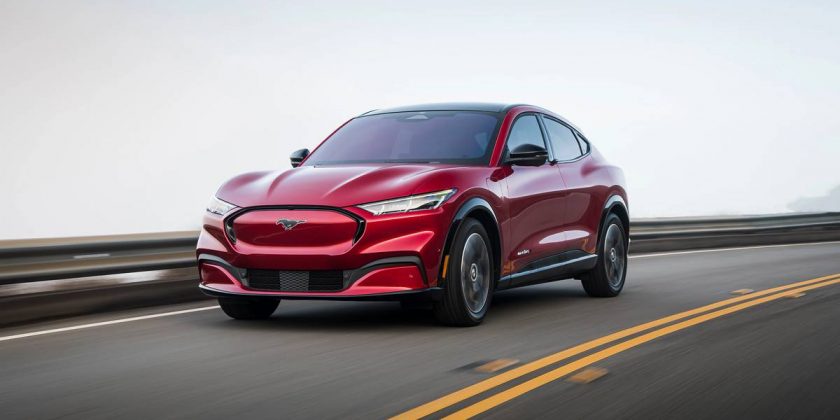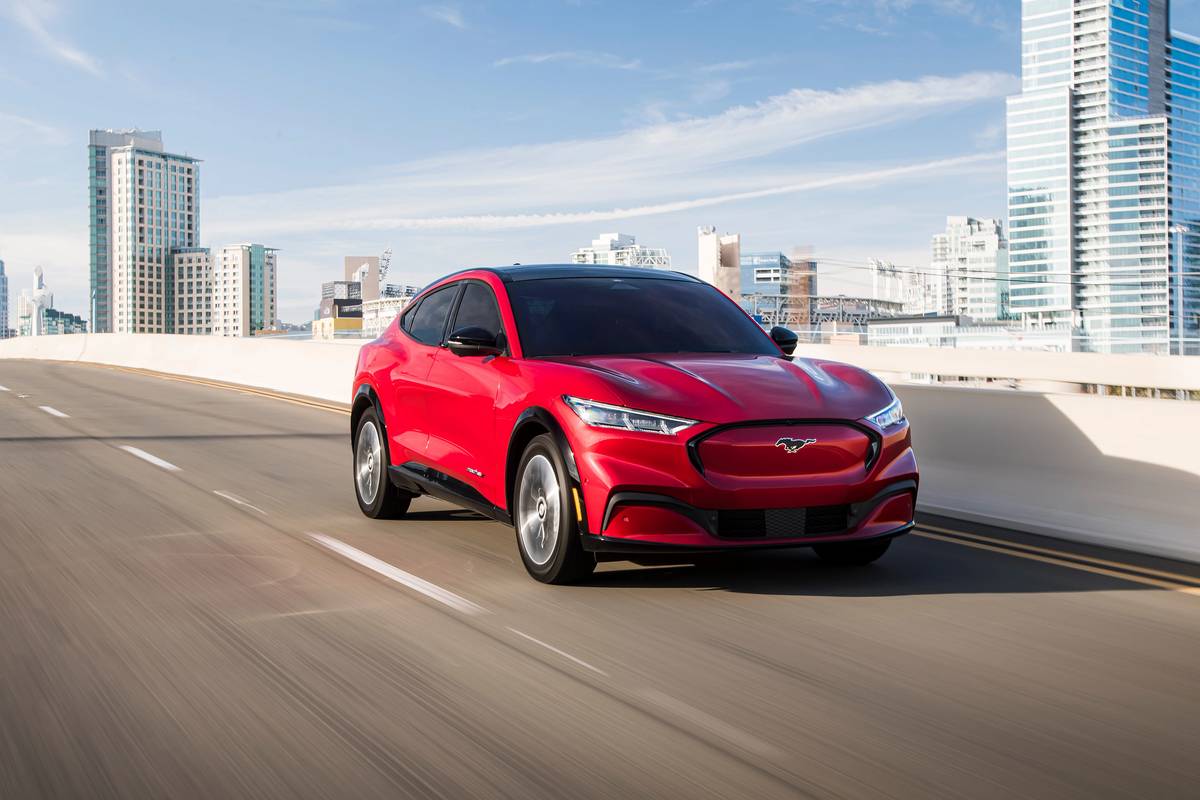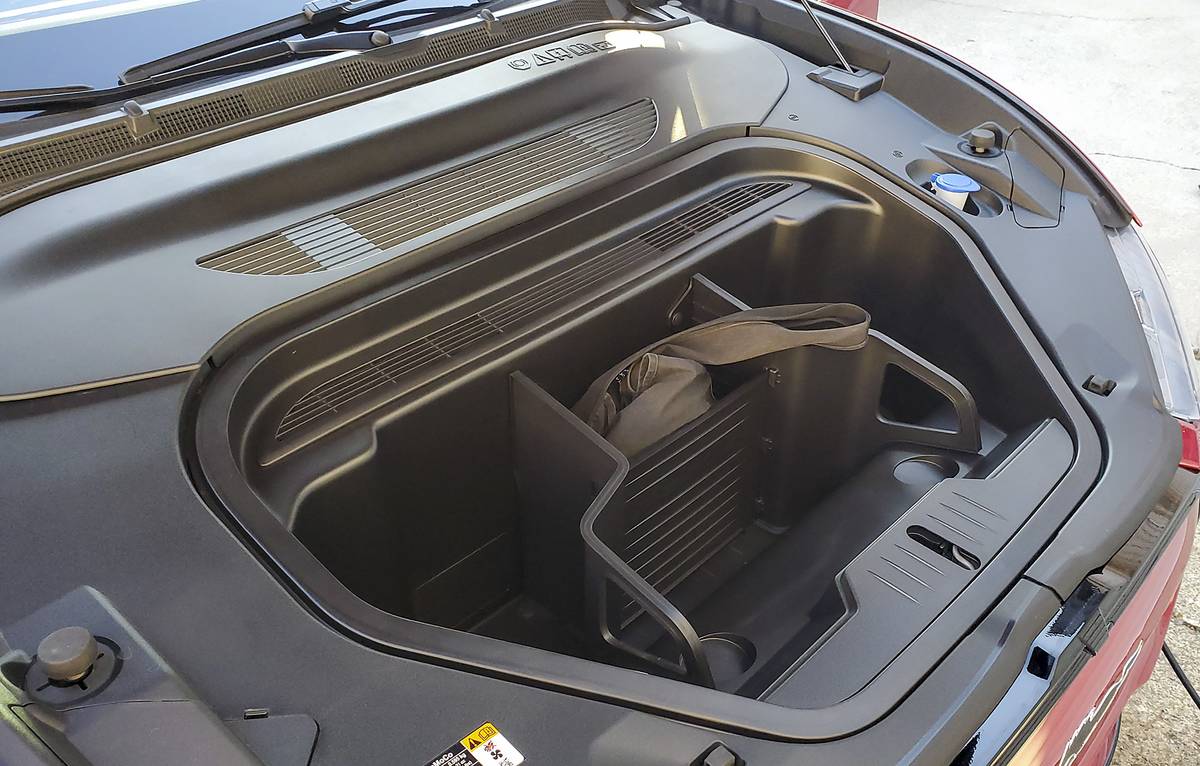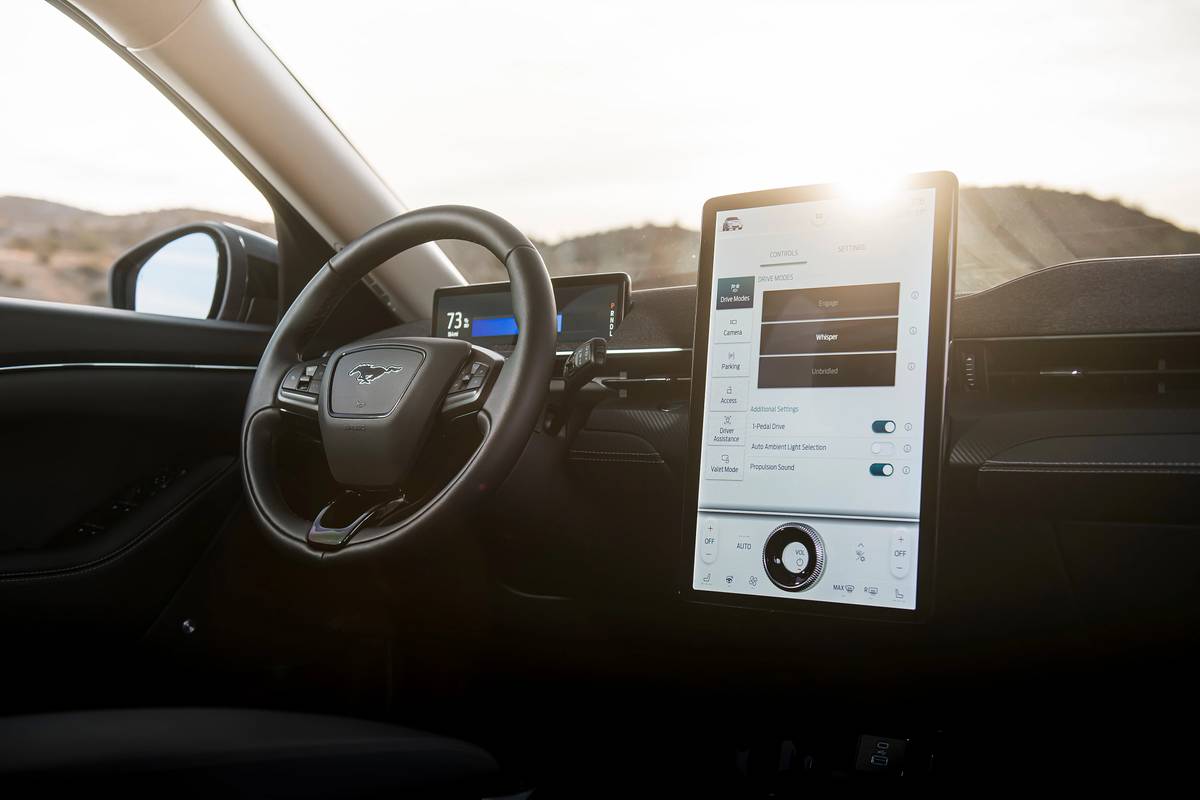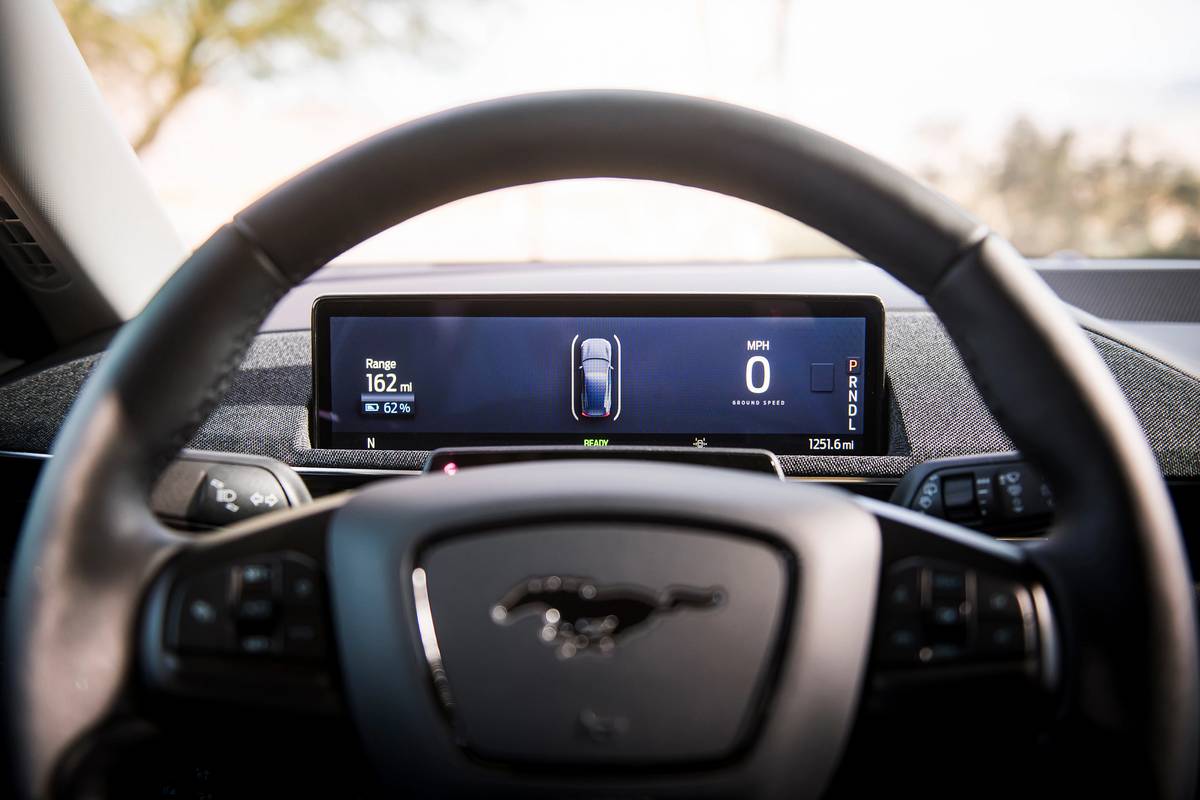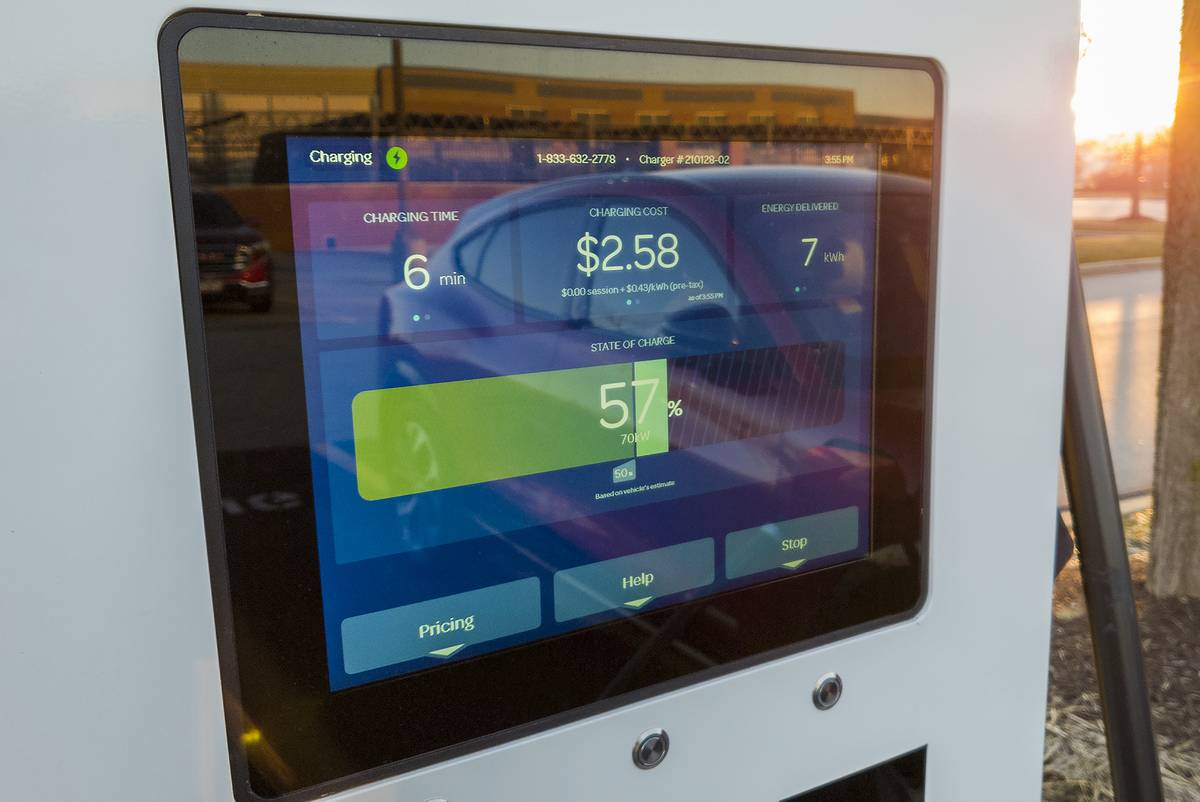The 2021 Ford Mustang Mach-E has a lot going for it, and a few things working against it. Most of the former is clear from looking at the specs, features and photos. I’m going to lay out a lot of those things, but there’s been a fair amount of praise out there about the Mach-E in the past week or so, and we at Cars.com have never been ones to hide a dissenting opinion. Buckle up for that as well.
Related: Ford Mustang Mach-E Leans Into Muscle-Car Moniker
Gobs of Good
As for what’s good about the Mach-E, just look at the numbers. EPA-estimated ranges extend from 211 miles with the base model’s battery and all-wheel drive to 300 miles with an optional higher-capacity battery and rear-wheel drive (Ford is targeting 305 miles in the California Route 1 version, currently unrated).
For the trim levels available now — Select, Premium, First Edition (sold out) and California Route 1 — prices range from $43,995 to $50,900 including destination charges but excluding a federal tax credit of up to $7,500 (depending on your finances). Assistant Managing Editor Kelsey Mays and I tested a Premium all-wheel-drive model with the higher-capacity battery over the course of 48 hours. It has separate front and rear drive motors with total 346 horsepower and 428 pounds-feet of torque.
The Mustang Mach-E is a good-looking, distinctive vehicle in a class where some models are peculiar and others are indistinguishable from gas-powered options. You get in by way of push-button door releases, which I’ve never been a fan of, but I can’t find fault with these. You simply push the button on the outside, and the door pops out. The front ones have wings you can grab as well. What’s this no-handle design about? It’s partly to remove the aerodynamic drag that comes from any kind of door handle. Apparently the front door wing handles at the base of the windows are designed with benign effect. Most important, the doors have normal-feeling release levers on the inside — unlike the electronic releases inside the Chevrolet Corvette, which never felt right to me.
Absent an engine under the hood, the Mach-E has a front trunk, and I wish I could praise it as much. It requires you to pull what’s essentially a hood release, twice, in the driver’s footwell in order to open it. There’s no handy push button on the car, key fob, touchscreen or app, as you would expect of a space intended for frequent use. The space itself is clearly secondary to the rear cargo area, but easier access would have been worthwhile.
As full battery-electric SUVs go (if that’s what this is), the Mach-E manages to be reasonably accommodating inside without being gigantic outside, unlike the pricey Jaguar I-Pace, another electric vehicle. We often have problems with Ford seats; these aren’t bad, but a bottom-cushion tilt adjustment is missing, and was missed. Rearward visibility isn’t great due to the thick rear window pillars. A full-time rearview-camera mirror would be a good addition.
In terms of controls, the Mach-E seems closest to the Tesla Model Y with a large touchscreen that looks like a floating tablet, but the Ford also has a minimalist instrument panel, itself a digital display, behind the steering wheel — something Tesla vows never to include. The Mach’s tablet measures 15.5 inches diagonally (13.5 inches excluding the fixed section for ventilation controls), and it’s oriented vertically rather than horizontally like the Model Y. Its large physical volume knob, which Ford plants in the lower-middle screen, is a plus, though I think Tesla’s onscreen interface is better. With its over-the-air updatability, there’s opportunity for improvements in this regard.
We Have Issues
Our one big takeaway about the Mustang Mach-E with 19-inch wheels was that it didn’t ride well. We set the tire pressures to spec, as we do religiously, but we found the ride quality hard and unsettled, particularly for a compact premium SUV. The car’s dynamics are decent, with the expected low center of gravity and minimal body roll. Our AWD car had a definite understeer bias nosing into a curve when off the power, but hitting the accelerator balances it out and even loosens up the tail. As is often the case with electrics, you can’t escape the feeling of the car’s weight when changing direction. Our Mach-E’s base curb weight is given as 4,920 pounds with all-wheel drive, an enormous 526 pounds higher than the rear-drive version.
Ride quality depends on personal preference and region (ride quality relates to road quality), and it’s worth noting that the Mach-E offers 18-, 19- or 20-inch wheels, all of which may affect tire profiles and ride harshness. To those ends, Kelsey and I are both sticklers on this issue, and there are many vehicles we think ride like hell that nevertheless sell in the millions (the Honda CR-V is one high-profile example). We live in the Chicago area, where the streets are paved yet disastrous, and there’s no shortage of rough riders like the CR-V on our mean streets.
Let’s put things in perspective: We think the Tesla Model S (passive suspension) and Model 3 are also too firm for our region, and by extension, the 3-based Model Y — a key Mach-E competitor — probably is, too (though we haven’t sampled it). But we’ve also spent decades heaping praise on Ford’s frequent ability to provide exceptional handling and ride together. Achieving these seemingly opposing goals in the same vehicle is so rare that I’ve questioned if Ford’s engineers made a pact with the devil. For the Mach-E, well, perhaps their number was up. Or maybe electric-vehicle ride quality is just that difficult. Many examples ride firmly, and not all of them can use sportiness as a convenient excuse. Of the recent crop, I was most comfortable in the Polestar 2, which had manually adjustable shock absorbers set on the softer side. (Laugh if you must, but if the only thing making a car incompatible with your region or preferences is suspension tuning, a one-time adjustment is a pretty compelling option.) The Polestar 2 has its own limitations, most notably its price, partly because of import tariffs (it’s assembled in China).
Another disappointment for a car bearing the Mustang badge was the braking — not the stopping power, which seemed strong, but the pedal action and controllability. We found it very grabby to start and nonlinear through the range of travel. Regenerative braking action has always been difficult to perfect, but it’s been improving across the market. Not so much here. I switched to the Mach-E’s driver-selectable 1-Pedal Drive mode, which activates strong enough braking when you lift off the accelerator that you barely have to use the brake pedal at all. I always like this type of mode even when not trying to avoid a frustrating pedal, and you might find yourself trying it even if you don’t usually care for it. In the Mach-E’s default mode, the car barely decelerates when you don’t step on the brakes. It just. Keeps. Going.
Regenerative braking has a major software component, so we wonder if any part of what we experienced could be improved with code updates, perhaps using the Mach-E’s over-the-air updatability. It is early, and the car is designed to evolve and improve, as Teslas have done for years. To that end, we had a few other quirks with our early release:
- Neither Android Auto nor Apple CarPlay were functional for our phones, either wirelessly or when attached via USB cables.
- The Propulsion Sound wouldn’t work for the first few hours of our loan. We’d use the touchscreen to turn the defeatable feature on, and it would slide back off again before our eyes. Eventually it just started working on its own.
- We attempted to use a smartphone as a key, but it got stuck while downloading despite several attempts. To Ford’s credit, most automakers don’t even attempt to give reviewers access to smartphone apps, and we found the FordPass app useful for monitoring charging status, setting up the car without being in it and spying on other journalists after we turned the car back in.
Is It a Mustang?
The Mach-E’s Mustang-inspired external design and the words “GROUND SPEED” under the speedometer are essentially where the similarities end. This SUV is based on a different platform from the real Mustang, and the decision to call it a Mustang was a marketing move — a defensible and possibly brilliant one. (It generates buzz and underscores that electric cars can be fun and sporty.) We knew it wouldn’t drive like a Mustang before we got behind the wheel. Now that we have, we can say it categorically doesn’t drive like a Mustang. Granted, it’s quick, with 0-60-mph estimates as high as 6.1 seconds with the larger battery and RWD to as low as a targeted 3.5 seconds in the coming GT Performance Edition, according to Ford. It has the flat cornering described above, too. But the experience is fundamentally different, and it clearly lacks the original’s decades of refinement.
Charging a Mach-E
Ford includes a mobile charger, which can be fitted with a plug for 120 volts or another one for 240 volts. With the latter, this unit should be enough for most owners. Its capacity is 30 amps (requiring a circuit with a 50-amp breaker and a NEMA 14-50 outlet), good to add roughly 20 miles of range for every hour it’s connected, according to Ford. If you want to goose that to roughly 30 miles per hour, you can buy a wall-mounted Ford Connected Charge Station for $799 plus installation. It delivers 48 amps but requires a heartier circuit and 60-amp breaker.
I confirmed Ford’s claim that the Mach-E adds about 3 miles of range for an hour of charging on a 120-volt household outlet drawing a decent 10.5 amps (some units go as high as 12 amps while others are stingier). This is not the way to charge a real EV, but the number of miles you can add at a set voltage and amperage is a window into the vehicle’s efficiency, and this is typical for a plug-in SUV. (Some cars add 5 miles per hour.)
I wasn’t able to test Level 2 (240-volt charging) because of our short loan, but it bears noting that every Mach-E has an onboard charger (the hidden hardware converts AC to DC for Level 1 and 2 charging) with a 10.5-kilowatt capacity, which translates to faster charging than many EVs support if they’re fed enough current at 240 volts AC. Most of today’s electric cars top out at 6.6 kW (Nissan Leaf) or 7.2 kW (Chevrolet Bolt EV), and even some less-efficient SUVs like the Jaguar I-Pace and Audi E-Tron accept only 7 kW and 9.6 kW, respectively. All of that exacerbates the fact that the same amount of current for the same period already translates to fewer miles of range for these models than it does in the Mach-E (more on that next). For reference, Tesla onboard chargers currently range from 7.7 to 11.5 kW, and the coming 2021 Volkswagen ID.4 is rated at 11 kW.
Onboard charger capacity isn’t the only thing that determines how quickly a plug-in can charge. How efficiently the vehicle operates is primary. The EPA rates the Mach-E at 90-100 mpg-equivalent combined, depending on the version, which is better than some. The agency’s mpg-e means little relative to gas-powered vehicles, but it’s good for comparing EVs with each other. The I-Pace is rated a pathetic 76 mpg-e combined, only slightly better than the Porsche Taycan (69 mpg-e at best). The little Volvo XC40 Recharge is also surprisingly bad at 79 mpg-e. The VW ID.4 is rated 97 mpg-e, and the two Tesla Model Y versions currently rated are 111 and 125 mpg-e. For what it’s worth, no one comes near Tesla’s efficiency: Three versions of its Model X SUV, which is considerably larger than the Mach-E, rate higher, up to 105 mpg-e. But the fact that the rest of the models are rated more efficient than the top Mach-E are cars (or cars masquerading as SUVs, like the Hyundai Kona) prove that Ford is doing it right.
I also sought out a higher-powered public DC fast charger because the Mach-E can accept up to 150 kW for a claimed 61 miles in just 10 minutes. Some EVs can’t accept this much DC power, and some charging stations don’t provide it. The fast charger 2 miles from my home is limited to 24 kW. The 50-kW option 7 miles away has been “under repair” for months. A new Electrify America location (150 kW) 3 miles away was also broken, so I drove 7 miles to a different EA station. There, the first of four kiosks I tried failed to work twice; EA remotely rebooted the unit after I called, and then it still failed before I was directed to a different “pump” at the same station. That unit worked.
Why do I tell you all this? Because this kind of thing is all too common at this stage of the EV revival, at least where I live. Cars.com’s editors want, need and support EVs, but we’re not going to tell you the ownership experience is free of frustrations — especially when it comes to public charging, which is seldom satisfying even at its best, because even “fast” charging isn’t very fast if you’re comparing it to a gas pump. The way to own an electric car is to charge it at home and use public charging as a backup.
Compatibility problems between the latest EVs and charging stations isn’t uncommon, and in this case the obstacle seems to be the one charging unit that combines the older CHAdeMO connector with the nearly universal Combined Charging System connector used by the Mach-E. (Electrify America says the problem will be addressed.) Once I moved over to one of the functional CCS-only chargers, the station automatically recognized the car and its already set-up account, and it started charging before I could use my own app. This Tesla-like seamlessness is welcome.
The charging station showed it was delivering 87 kW to the Mach-E, but it never went higher than that. Ford says the factors that influence charging rate include external temperature, battery temperature and the battery’s state of charge. The latter might be the issue because my car’s battery was at 50% when I started (all batteries charge faster when empty). All the same, it piled on miles of range, going from an estimated 106 miles to 195 in 28 minutes. I quit at 81% battery capacity when I realized the charging rate had plummeted to just 12 kW at the magic 80% mark, which is when all EVs I’ve tested slow things down to prevent damage.
According to Electrify America, the session delivered 31 kilowatt-hours and cost $13.31. That rounds up to 15 cents per mile, which is no bargain, but fast charging seldom is when you’re the one paying. For comparison, the 3 miles I added at home (1.28 kwh per my meter) is just over 5 cents per mile based on my utility rate of 12 cents per kwh. This is decent for an electric SUV, and cheaper than the 8 cents per mile you’d pay to drive a 2020 Ford Escape AWD rated 28 mpg combined on today’s cheap gasoline ($2.25 as I write this). The Mach-E Premium AWD (not the most efficient version) even edges out an Escape Hybrid AWD, rated 40 mpg combined, by a half-cent in my region. Due to regional differences in electric and gas prices, your results may vary.
The EV That Has It All?
I admit, I was ready to love the Mach-E based on all of the important considerations you can see on paper and through images. It has the range, charging rate, pricing, size, features and even the styling to be a mass-market hit, and that’s been sorely missing in a market subsegment with small cars at one end and high-priced luxury SUVs at the other.
Driving it tempered my enthusiasm quite a bit. Some of that might come because it was an early and glitchy sample, but not all of it. I’m looking for the electric vehicle that has it all, and at first blush, the Mach-E doesn’t seem to be it. But neither does anything else. So far.
More From Cars.com:
- 2021 Ford Mustang Mach-E Range on 10-Minute Charge Better Than Expected
- 2021 Ford Mustang Mach-E: Not Really a Mustang, But That’s OK
- 2021 Ford Mustang Mach-E: First Edition First to Sell Out
Related Video:
Cars.com’s Editorial department is your source for automotive news and reviews. In line with Cars.com’s long-standing ethics policy, editors and reviewers don’t accept gifts or free trips from automakers. The Editorial department is independent of Cars.com’s advertising, sales and sponsored content departments.
Source: Read Full Article
